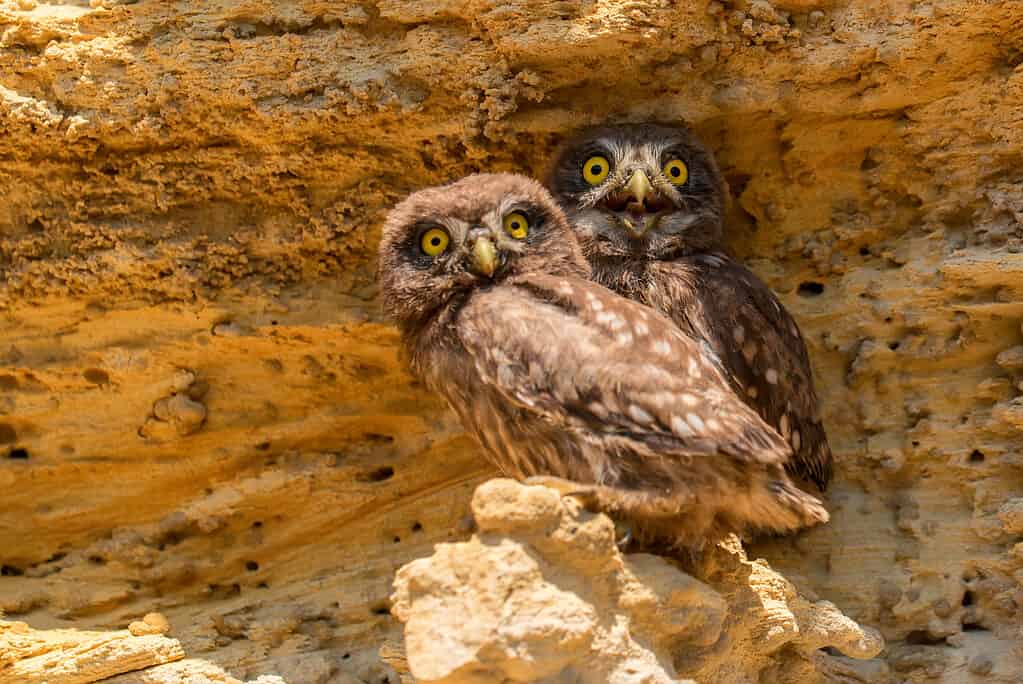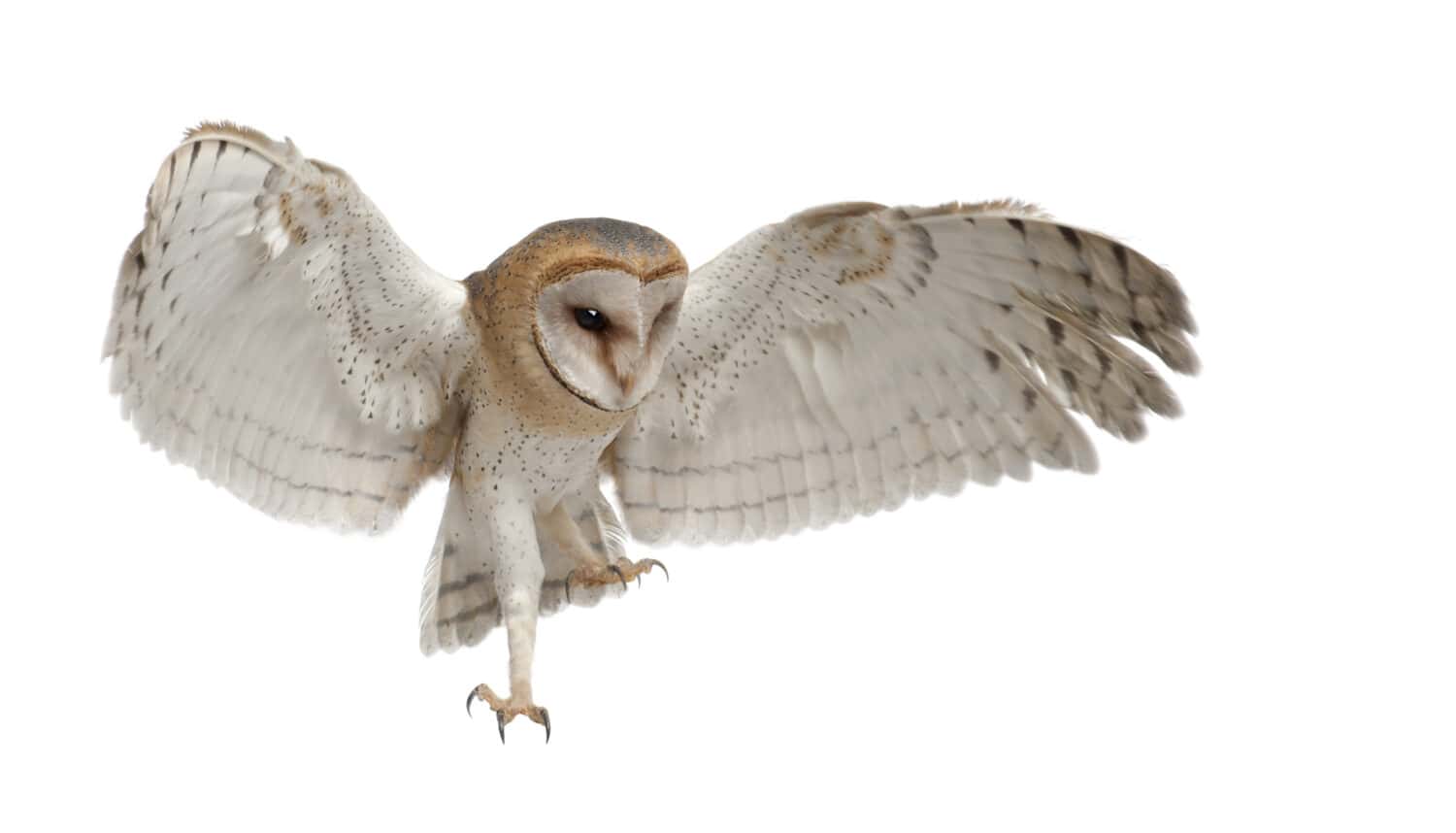How smart and wise are owls?
Owls often get painted as super smart and all-knowing in stories, but the truth isn’t exactly like that. Owls’ eyes are bigger than their brains, and they can easily be outsmarted by a clever crow. However, even though owls might not live up to their wise reputation, that doesn’t mean they’re dumb. An owl’s brain is made for survival and adaptation; which is why you can find them everywhere in the world (except Antarctica). Even the cold doesn’t scare them off —just look at the snowy owl, who hangs out by the North Pole.
There are more than 200 kinds of owls, and they all belong to a group called Strigiformes. They have famously huge eyes and zygodactyl feet with two toes facing forward and two toes facing backward. From one species to the next, these birds can be wildly different. The elf owl is so small it weighs less than 2 ounces, while the largest owl in the world can weigh nearly 6 pounds. And let’s not forget the barred owl, who’s so loud people call it the “hoot owl.
Even though owls might not have endless wisdom as we hear in stories, their differences, ability to fit in anywhere, and adaptations make them worth learning about. Follow along as we unveil the true story about owls.
Summary of the Mental Abilities of Owls

Owls display their cleverness by adapting to different habitats all around the world.
©iStock.com/Oskanov
For birds, intelligence means being able to do things well and solve problems. Owls show their intelligence in how they hunt and adapt to their surroundings. A big part of their brain is used for seeing and hearing things. An owl’s brain uses both its ears and eyes to create a map of its surroundings and find its prey. That’s why owls are masters of their environment. They’re also really good at moving quietly, making them nearly invisible when they fly. This helps them have great success on their nightly hunts.
Owls aren’t brainiacs. Instead, most of the space in their skull is rented out by their eyes. Their oversized eyes can make up to 5% of their body weight; their long and tube-shaped, like a lightbulb. The part we can see on their face isn’t even the biggest part. The “bulb” or the biggest part of their eyes, rests at the back of their boney eye sockets. Unlike humans, whose eyes are held in place by muscles, owls have boney structures. The reason for their big eyes is that they need to be able to let in a lot of light to see at night.
Cognitive Capabilities: Understanding Owl Problem-Solving Skills and Learning Aptitude
Certain owls are smart enough to use tools to catch their meals. And their tool of choice just so happens to be poop. Burrowing owls have been observed using animal droppings to strategically attract dung beetles, a major source of their prey. They place the scat around the beetle’s holes and wait for them to pop up. This stinky strategy is very effective. Scientists looked at pellets and beetle parts near owl burrows. They discovered that when there was dung around, owls ate 10 times more dung beetles and six times more kinds of beetles.
Owls Use Statistical Inference to Find Prey

Most owls focus on sounds in the middle of their vision.
©Ondrej Prosicky/Shutterstock.com
Owls are capable of using “statistical inference,” which is like making good guesses based on the information at hand. To study this, researchers made a special math model using Bayesian inference to understand how owls find sounds. Bayesian inference is a statistical method used to update beliefs or probabilities as new evidence or information becomes available. And for owls that new information is sound.
Most owls focus on sounds that are in the middle of their vision. This might make them miss prey on the side, but it makes them incredibly precise with finding things in front of them. Here’s where the brain power comes into play. As the owl hears more sound cues or gathers more information about the sound, its brain adjusts its estimation of where the sound is coming from. This involves updating probabilities based on the combination of current cues and past experiences. So owl brains are capable of completing complex equations to help them guess where prey is most likely to be.
Intelligence in the Animal Kingdom: Comparing Owls to Other Species
Eagles, pigeons, crows, ravens, and ducklings, can be thought of as smarter than owls. Here, “smart” refers to being able to handle more intricate thoughts. In the bird world, crows are wise wizards, and owls as blood-thirsty barbarians.
Pigeon vs. Owl
Pigeons are smarter than owls. Pigeons are much smarter than people might think. They share a basic learning process with AI, like making connections and spotting patterns. And they can recognize themselves in mirrors, just like we do.
Crow vs. Owl
Crows are smarter than owls. Crows display relational matching behavior, a type of analogical reasoning. They can see similarities between things they’ve seen before and new things they come across. For example, if they know how to solve a puzzle, they might use that knowledge to figure out a new puzzle that’s a bit different but kinda similar. They display this behavior naturally, without any special training. This natural ability to respond relationally provides compelling proof of analogical reasoning in a nonprimate species. Before, only apes had showcased this ability through identity matching-to-sample training.
Duckling vs. Owl
Ducklings are smarter than owls. Ducklings are capable of abstract thought. Primates and humans also have this ability. Abstract thought means being able to understand the concept of the same and different. It’s also about being able to think about things that aren’t in front of you. Mallard ducklings don’t just remember sensory information, what they hear, see, and smell, but they can also remember if two things are alike or not.
Raven vs. Owl
Ravens are smarter than owls. Ravens can plan for the future, which is something not a lot of animals can do. They also have a great memory for faces, so they can recognize and remember people they’ve seen before. They can even hold grudges. If someone or something upsets them, they won’t forget it easily.
When it comes to solving puzzles, ravens are like puzzle-solving champions. They can handle complicated puzzles that have many steps, a bit like how young kids do. They’re as good at solving problems as some big apes are. These clever birds can also use tools to get their food. All this intelligence plays a big role in how ravens interact with each other. Their complex social structure is astonishing. They even have a way of warning each other about people they don’t like.
Scrub Jay vs. Owl
Scrub jays are smarter than owls. These clever birds belong to the corvid family, which also includes crows, ravens, and jays. In North America, there are four species of scrub jays: the Florida scrub jay, the California scrub jay, Woodhouse’s scrub jay, and the island scrub jay. These birds have relatively large brains for their body size. This makes them likely smarter than owls, as seen in their impressive behaviors.
For example, scrub jays excel at hiding their food. They have an incredible memory for the locations of thousands of food items and are even cautious about potential observers. Scrub jays can also adapt their hiding spots based on their future needs. They can also discern which insects are tasty and which are not.
Scrub jays can also predict what they might know in the future, a concept known as prospective metacognition. To put it simply, metacognition involves understanding your own knowledge and thinking process. Much like how we can mentally revisit the past or envision future events, scrub jays can do the same. They can differentiate between what they know and what they don’t, taking appropriate actions when they realize their knowledge gaps, like seeking hints or cues.
Past Discoveries and Studies on Owl Intelligence

Owls know how to memorize landmarks to navigate their hunting territories.
©iStock.com/mzphoto11
Owls can tell apart different kinds of prey and switch up their hunting patterns to ensure success They don’t just target prey based on size (although that’s a factor), they also use memory and patterns. In one study on how owls choose prey, scientists looked at pellets from five types of owls and found that owls learn to hunt better depending on the kinds of prey around them.
And that’s not all. Owls often establish hunting territories that provide a consistent source of prey. These birds are so smart, they’re able to memorize key landmarks and navigate through their territories efficiently. This demonstrates their abilities in spatial memory and navigation.
These ancient birds are also good at mixing their senses. They balance between tuning in to their sharp eyes, strong hearing, and silent flying skills. Their eyes face forward, which helps them see things with binocular vision, so they know how far things are. And the circular facial feathers direct sounds towards their ears, so they can accurately locate prey even before laying eyes on it.
Owls: Surviving for 60 Million Years Through Intelligence and Adaptation

Fossils show owls are ecologically adaptable, another sign of their innate survival skills.
©Douwe Schut/Shutterstock.com
Owls have one of the oldest fossil records among modern birds, spanning from about 60 million years ago to the present. These silent hunters have been found in the fossil record from the Pleistocene to the Paleocene, predominantly found in Europe and North America.
Ancient Diurnal (Daytime) Owls
One particularly old and recently found fossil provides evidence of daytime behavior in owls millions of years earlier than previously thought. The fossil owl’s pupils were small, indicating good vision with a smaller eye opening, which is characteristic of diurnal animals. The fossil is proof that owls are ecologically flexible through morphological adaptation. This challenges the view that modern diurnal owls are an evolutionary anomaly. While most owls hunt at night, some owls like the snowy owl and northern hawk owl take advantage of sunlight hours.
The Barn Owl’s Brilliant Brains

Skilled barn owls forcefully strike the ground when hunting to penetrate layers of snow or leaves.
©Eric Isselee/Shutterstock.com
Barn owls have many names; Monkey-faced Owl, Ghost Owl, and Night Owl. They’re not too big, not too small – just medium-sized. Their easy to spot with their heart-shaped face and asymmetrical ears. One ear sits higher and is covered in feathers to help them hear better. Like most owls, barn owls have powerful brains. Scientists have been trying to understand exactly how their brains work, and they’re finding out some pretty amazing things. Like, for instance, how these owls hear sounds on their left and right sides.
Barn owls use something called interaural time differences (ITDs) and interaural level differences (ILDs) to figure out where sounds are coming from. It’s like the owl’s brain has a special map for hearing that helps them know where sounds are. The owls can even tell if a sound is up or down using ILDs. The owl’s brain also puts together how loud a sound is to know where it’s coming from.
Oldest Owl Species
Barn owls are thought to be one of the oldest owls in the world. And perhaps they’re the smartest too! Barn owl brains show similarities to human brains. It’s likely they make mental maps of their environment, just like we do. This skill isn’t unique to owls; it’s seen in creatures with and without backbones. This mental mapping ability likely developed a very long time ago, possibly hundreds of millions of years in the past.
Highly Adaptable
Barn owls display their intelligence in several ways. For starters, they’re able to adapt to a variety of habitats, especially in North America. They like homes with open spaces and a few trees. You can find them in barns, buildings, or even on cliffs. Instead of making nests, they find safe spots to lay their eggs. They can lay a lot of eggs at once, which is probably one of the reasons their species has survived millions of years.
Skilled Hunters
Like all owls, barn owls are skilled hunters, capitalizing on their exceptional eyesight and acute auditory capabilities. Nocturnal by nature, they conduct their hunting flights close to the ground over fields, going back and forth as they search for prey. Excelling in both hearing and vision, Barn Owls can navigate in low-light conditions adeptly. Farmers like having them around because Barn Owls eat the rats and mice on their land.
Planned Forceful Strikes
Acoustically hunting barn owls are famous for striking their prey with forceful blows. In the past, people thought that barn owls hit their prey hard to quickly kill them. However, new research tells a different story. Barn owls have sharp claws, a strong grip, a curved beak, and the ability to swallow prey whole. So, they don’t need to stun the mouse before attacking. Now we know that the real reason behind their forceful strikes has to do with breaking through obstacles. By being able to quickly go through snow or layers of leaves, their more likely to snatch their prey.
Unique Vocalizations
Finally, barn owls make complex sounds. Contrary to the typical hooting sounds of many owl species, Barn Owls emit a sharp, 1-2 second screech. Males use this call for mating purposes and also resort to hissing as a means to deter predators. During their breeding phases, these owls produce an array of sounds including screeches, hisses, and purrs.
Final Thoughts
Owls might not be as wise as the stories say, but they’re still really smart in their way. They’ve been around for a long time, over 70 million years, and they’re experts at surviving all over the world. There are more than 200 kinds of owls, and they’re all different sizes and shapes. And some owls, like burrowing owls, are clever enough to trick bugs into coming close so they can catch them. They might do it with animal droppings, but it’s a wise move nevertheless.
The photo featured at the top of this post is © SunflowerMomma/Shutterstock.com
Thank you for reading! Have some feedback for us? Contact the AZ Animals editorial team.







